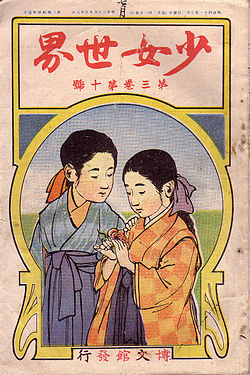Shōjo Sekai: Difference between revisions
m combine cats |
Date links per wp:mosnum/Other |
||
| Line 21: | Line 21: | ||
|issn = |
|issn = |
||
}} |
}} |
||
{{nihongo|'''''Shōjo Sekai'''''|少女世界|}} was one of the first ''[[shōjo]]'' [[magazine]]s in [[Japan]]. It was published by [[Hakubunkan]] beginning in |
{{nihongo|'''''Shōjo Sekai'''''|少女世界|}} was one of the first ''[[shōjo]]'' [[magazine]]s in [[Japan]]. It was published by [[Hakubunkan]] beginning in 1906 and was initially edited by renowned children’s author {{nihongo|Sueo Iwaya|巌谷孝雄}}, better known by the pen name {{nihongo|[[Sazanami Iwaya]]|巌谷小波}}.<ref name = kikuyo>[http://www.kikuyo-lib.jp/top.html {{nihongo3|Kikuyō Town Library|菊陽町図書館|Kikuyō-chō toshokan}}]. [http://www.kikuyo-lib.jp/08_menu.htm {{nihongo3|“[[Meiji Period|Meiji]] to [[Shōwa Period|Shōwa]]: An Introduction to Girls' Magazines”|明治〜昭和 少女雑誌のご紹介|Meiji - Shōwa shōjo zasshi no goshōkai}}]. Retrieved on 2008-09-16.</ref><ref>[http://www.f2.dion.ne.jp/~sanko/index.html {{nihongo3|Sankō Library|三康図書館| Sankō toshokan}}]. [http://www.f2.dion.ne.jp/~sanko/zasshiweb03_02.html {{nihongo3|Sankō Library Collection Search - Magazines|三康図書館蔵書検索ー雑誌| Sankō toshokan zōsho kensaku - zasshi}}]. Retrieved on 2008-09-16.</ref> ''Shōjo Sekai'' was created as a sister magazine to {{nihongo|''[[Shōnen Sekai]]''|少年世界||lit. ''Children's World''}}, which was also edited by Iwaya, and which began publication in 1895.<ref>[http://azure.x0.com/ Nakagawa, Hiromi {{nihongo2|中川裕美}}] (2002). [http://azure.x0.com/gyouseki/kodomo.html {{nihongo3|“The Birth and Transformations of ‘Girls’ Magazines’ in Our Nation”|我が国における『少女雑誌』の誕生と変遷|Waga kuni ni okeru “shōjo zasshi” no tanjō to hensen}}]. {{nihongo3|''Chukyo Women's University Children's Culture Studies, No. 9''|中京女子大学子ども文化学研究 第9号|Chūkyō Joshi Daigaku Kodomo bunkagaku kenkyū dai kyū gō}}. Nagoya: [http://www.chujo-u.ac.jp/ {{nihongo3|Chukyo Women's University|中京女子大学|Chūkyō Joshi Daigaku}}]. Retrieved on 2008-09-16.</ref> |
||
According to Nagai, for the first ten years of its publication it was the best-selling shōjo magazine of the time, with peak circulations somewhere between 150,000 to 200,000 copies per issue.<ref>Nagai, Kiyoko ({{nihongo2|永井紀代子}}) (2000). {{nihongo3|"Birth of the Girls’ Liberated Zone: ''Girls’ World'' and ‘Girls’ Reading Circles’"|誕生・少女たちの解放区〜『少女世界』と「少女読書会」|Tanjō - shōjotachi nokaihōku: “Shōjo Sekai” to ‘shōjo dokusho kai’}}. In {{nihongo3|“Women’s and Men’s Space-Time 9”|女と男の時空 9|Onna to otoko no jikū kyū}}, edited by Nobuko Kohno ({{nihongo2|河野信子}}), pp. 278-311. Tokyo: Fujiwara Shoten {{nihongo2|藤原書店}}. ISBN 978-4894342125.</ref> |
According to Nagai, for the first ten years of its publication it was the best-selling shōjo magazine of the time, with peak circulations somewhere between 150,000 to 200,000 copies per issue.<ref>Nagai, Kiyoko ({{nihongo2|永井紀代子}}) (2000). {{nihongo3|"Birth of the Girls’ Liberated Zone: ''Girls’ World'' and ‘Girls’ Reading Circles’"|誕生・少女たちの解放区〜『少女世界』と「少女読書会」|Tanjō - shōjotachi nokaihōku: “Shōjo Sekai” to ‘shōjo dokusho kai’}}. In {{nihongo3|“Women’s and Men’s Space-Time 9”|女と男の時空 9|Onna to otoko no jikū kyū}}, edited by Nobuko Kohno ({{nihongo2|河野信子}}), pp. 278-311. Tokyo: Fujiwara Shoten {{nihongo2|藤原書店}}. ISBN 978-4894342125.</ref> |
||
The final issue of ''Shōjo Sekai'' was the December |
The final issue of ''Shōjo Sekai'' was the December 1931 issue.<ref name = kikuyo/> |
||
==Contributors== |
==Contributors== |
||
Revision as of 20:35, 5 October 2008
 | |
| Editor / Publisher | Sazanami Iwaya |
|---|---|
| Categories | Shōjo, fiction, nonfiction, poetry, illustration, photography |
| Circulation | 200,000 (peak in 1910) |
| Publisher | Sazanami Iwaya |
| First issue | 1906 |
| Final issue | December 1931 |
| Company | Hakubunkan |
| Country | Japan |
| Language | Japanese |
Shōjo Sekai (少女世界) was one of the first shōjo magazines in Japan. It was published by Hakubunkan beginning in 1906 and was initially edited by renowned children’s author Sueo Iwaya (巌谷孝雄), better known by the pen name Sazanami Iwaya (巌谷小波).[1][2] Shōjo Sekai was created as a sister magazine to Shōnen Sekai (少年世界, lit. Children's World), which was also edited by Iwaya, and which began publication in 1895.[3]
According to Nagai, for the first ten years of its publication it was the best-selling shōjo magazine of the time, with peak circulations somewhere between 150,000 to 200,000 copies per issue.[4]
The final issue of Shōjo Sekai was the December 1931 issue.[1]
Contributors
Shōjo Sekai had a number of well known contributors over the years, including the following:
- Sazanami Iwaya ([[:ja:巌谷小波|巌谷 小波]]), author, children's author, editor, publisher
- Yasunari Kawabata, novelist and short story author
- Chiyo Kitagawa (北川 千代), children's author
- Tama Morita, essayist
- Midori Osaki ([[:ja:尾崎翠|尾崎 翠]]), novelist
- Kikuko Oshima (尾島 菊子), author
- Akiko Yosano, poet, feminist, pacifist, and social reformer
References
- ^ a b Kikuyō-chō toshokan (菊陽町図書館, Kikuyō Town Library). Meiji - Shōwa shōjo zasshi no goshōkai (明治〜昭和 少女雑誌のご紹介, “Meiji to Shōwa: An Introduction to Girls' Magazines”). Retrieved on 2008-09-16.
- ^ Sankō toshokan (三康図書館, Sankō Library). Sankō toshokan zōsho kensaku - zasshi (三康図書館蔵書検索ー雑誌, Sankō Library Collection Search - Magazines). Retrieved on 2008-09-16.
- ^ Nakagawa, Hiromi 中川裕美 (2002). Waga kuni ni okeru “shōjo zasshi” no tanjō to hensen (我が国における『少女雑誌』の誕生と変遷, “The Birth and Transformations of ‘Girls’ Magazines’ in Our Nation”). Chūkyō Joshi Daigaku Kodomo bunkagaku kenkyū dai kyū gō (中京女子大学子ども文化学研究 第9号, Chukyo Women's University Children's Culture Studies, No. 9). Nagoya: Chūkyō Joshi Daigaku (中京女子大学, Chukyo Women's University). Retrieved on 2008-09-16.
- ^ Nagai, Kiyoko (永井紀代子) (2000). Tanjō - shōjotachi nokaihōku: “Shōjo Sekai” to ‘shōjo dokusho kai’ (誕生・少女たちの解放区〜『少女世界』と「少女読書会」, "Birth of the Girls’ Liberated Zone: Girls’ World and ‘Girls’ Reading Circles’"). In Onna to otoko no jikū kyū (女と男の時空 9, “Women’s and Men’s Space-Time 9”), edited by Nobuko Kohno (河野信子), pp. 278-311. Tokyo: Fujiwara Shoten 藤原書店. ISBN 978-4894342125.
